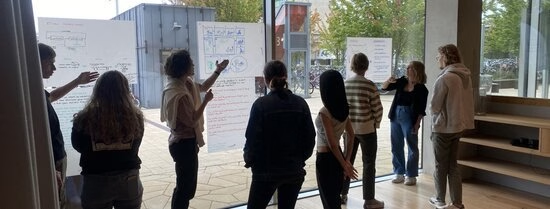How do we get students to ask more questions during a museum visit? Let them free an Egyptian princess from a sarcophagus! In the minor Living Education Lab, students from Leiden University, TU Delft and Erasmus University Rotterdam (LDE) designed an escaperoom for the National Museum of Antiquities.
Asking questions to free a princess
Teachers want students to participate in a museum visit, so that it gets really fun and meaningful. The problem is that students don't ask questions because they don't know the environment or the tour guide. Moreover, they are not used to asking questions or do not know how to do so. Students from the LDE living Education Lab minor got to work on this and designed a virtual escaperoom: Students are given an audio tour and hear an Egyptian princess, Amara, call for help. They must free her from a sarcophagus in which her evil sister has trapped her. Students ask questions and must find connections and objects in the museum that will help free Amara. Meanwhile, a chatbot provides feedback, increasing student engagement. At the end, they can see how well they did compared to other classes. A great example of where the Living Education Lab minor led this spring.
Real life issues
The minor Living Education Lab is a result of a collaboration between Leiden University, TU Delft and Erasmus University Rotterdam. This minor combines the fields of design thinking and learning and teaching with technology with interdisciplinary group work. In the first part of the minor, students learn about the methodology of Design Thinking and work in groups to develop a solution to a problem of their own devising. In the second part, students apply what they learned in the first part of the minor and work in groups on a solution to a real-world educational issue. In consultation with the "problem owner," led by teachers from the three universities, students explore their target audience (empathize), research the problem statement (define), think about possible solutions (ideate), and develop (prototype) and test (test & evaluate) a solution.
Diversity and technology
Emma de Goeje and Kris Stabel were involved as teachers and coaches in the minor on behalf of EUR/Risbo. They look back on it with great pleasure. Emma: "It was great fun to work with students and teachers from three different universities and very different programs. From aorospace engeneering to psychology to computer science. That makes the creative thinking process extra rich." In addition to the escaperoom game, which encourages students to ask more questions during museum visits, another group designed a game box containing four games. Each game promotes algorithmic thinking and/or programming skills of students in a different way. Such a clever combination of learning, teaching and technology fits well in the minor, Emma believes: "Students are challenged to solve a problem using a new method and to work with new technologies. For example, several students built an app for the first time."
Pressure cooker design thinking
University students are usually not used to working according to the Design Thinking method, where you freely arrive at solutions and test them in practice. Instead of doing very extensive (theoretical) research, in Design Thinking you mainly try to put yourself in the position of the user, and you make a prototype as quickly as possible to test with that user, and to adjust where necessary. Emma adds: "The minor is designed in a way that students have to apply this method several times. In 20 weeks they go through all phases of Design Thinking twice. That really is designing in a pressure cooker."
Parts of this article have been derived from a news article of Leiden University about the Living Education Lab minor.
- More information
The minor is organized by ICLON Leiden, CLI, Risbo, and the Leiden-Delft-Erasmus Centre for Education & Learning. Read more about it on the Leiden-Delft-Erasmus website.
Risbo offers customized workshops for various educational issues or problems. We like to think along with you and we have the expertise to guide you from design to evaluation of a curriculum. Read more on the website or contact us directly.

